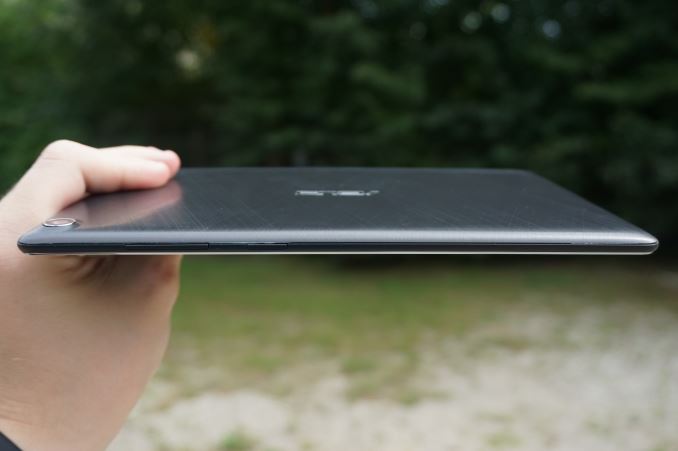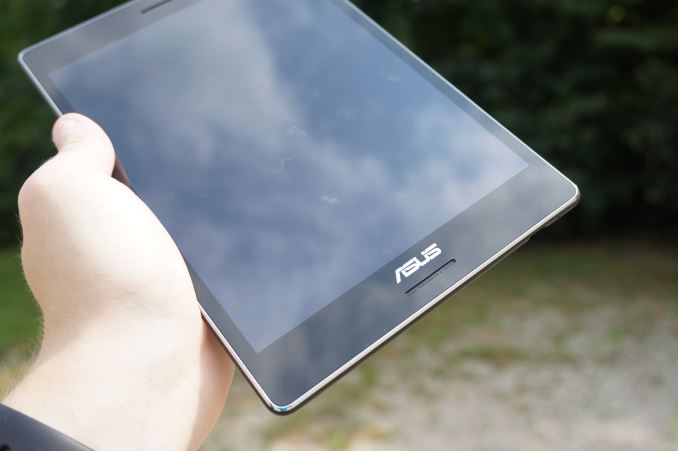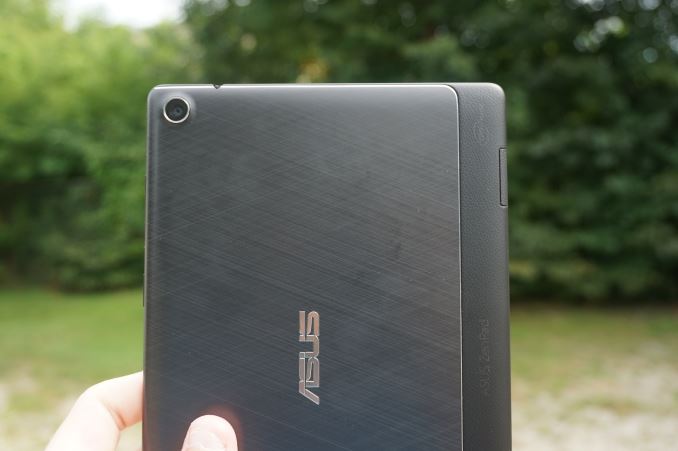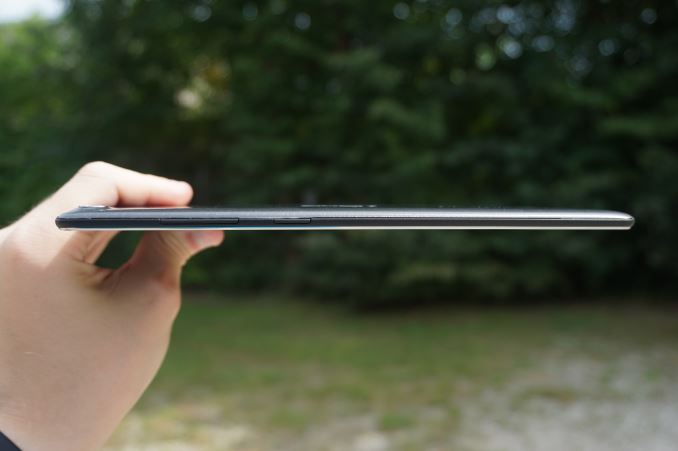The ASUS ZenPad S (Z580CA) Review
by Brandon Chester on August 31, 2015 8:00 AM ESTDesign
In my mind, I think of the ZenPad S Z580CA as a companion to the ZenFone 2. Both devices have an affordable price, and you can really buy both of them and still end up spending less than you would on a flagship smartphone. While they definitely share a UI and many internal hardware components, there isn't much similarity between the external design and construction of the two devices.
The first thing you'll notice when you pick up the ZenPad S isn't how the materials feel, but how incredibly thin and light the entire device feels. It's 6.6mm thick at its thinnest point, and the thickest point is only a small fraction of a millimeter thicker than that. Its mass is only 298g, which makes it the lightest tablet I've looked at to date. While it's not as thin as the iPad Air 2 or the Dell Venue 8 7840, the thickness and mass work together to give a feeling of lightness and portability that I've only ever experienced with one other device, which was the original iPad Mini.
There's not much to say about the front of the ZenPad S. Like all tablets, it's just a big display. ASUS has made space for two front-facing stereo speakers, which is something you won't get on an iPad or on the Galaxy Tab S2. As for the quality of the speakers, my highly subjective evaluation is that they are better than the iPad Air 2, and much better than the Nexus 9. They also don't cause significant chassis vibration despite the tablet's small thickness, which is something the iPad Air 2 suffers from.
Surrounding the edge of the ZenPad's front bezels is a metallic looking silver edge. This is really made of plastic, and like the plastic construction of the ZenFone 2 I'm a bit concerned about its durability. Readers may remember that a single fall from an extremely short height ended up scuffing up the back cover of our ZenFone 2 pretty badly. With the ZenPad S I have made sure to be quite careful, and haven't dropped it or hit it off anything to the best of my knowledge. Even so, there are some small dents in the silver edge. Pressing on it confirms that it's a fairly soft plastic, and I feel like it's going to be a magnet for these types of small dents and marks. In contrast, the Nexus 9 and iPad Air 2 testing units I have could probably be packaged and sold as brand new despite having them in my possession for significantly longer than the ZenPad S. If someone intends to use the ZenPad S as a tablet they can throw into their bag with other objects I would definitely be aware of the potential for damage to the edge.
The back of the ZenPad S is split into two sections. The smaller section has a soft touch feeling, and almost feels a bit like the pleather some phone cases are made of as it has a texture to it. This section is slightly thinner than the rest of the back cover, and it houses the tablet's MicroSD slot. What's interesting is that this part blends smoothly into the sides of the tablet, even though the sides have a distinctly different feeling due to their lack of texture. The soft touch part of the tablet also has the tablet's name and the Intel logo on it. However, it rubs off fairly easily as you can see in the image above, and at the time of writing this paragraph the logos have come off entirely.
The second part of the ZenPad back cover is a large plastic panel. In my review of the ZenFone 2 I said that the back cover of the phone did a good job of mimicking the appearance of aluminum, but felt entirely like plastic. The plastic segment of the ZenPad's back cover could actually convince you that it's made of metal unless you have the urge to tap on it. Like the ZenFone 2, the ZenPad's back cover has a shine to it that looks very much like the reflections made by brushed aluminum, although in the ZenPad's case the back cover has a pattern of overlapping diagonal lines rather than the straight lines of the ZenFone 2. Unfortunately, the hard plastic part of the back cover doesn't give any illusion of the tablet itself being made of metal, as you'll always be touching the soft touch plastic of the sides and the smaller segment of the back.
Right out of the box, my ZenPad S review unit did seem to have some issues with the hard plastic segment of the back cover that I think should have been picked up during QA. As you can see in the images above, there are areas on the edge of the plastic that are warped in such a way that they are no longer smooth like the other sections. It looks like these areas weren't finished properly, and when you look at the tablet from the side you can see that the entire edge around the power button and volume rocker is improperly formed and doesn't have the same color as the rest.
Ultimately I think the ZenPad S does a good job at being what it is, which is a tablet with a plastic chassis. My big concern is that the iPad Mini 2 sits at exactly the same price, and offers a completely aluminum chassis that feels much higher quality and will likely not incur the damage I've seen on the ZenPad's edge and back cover. The iPad is obviously heavier and thicker though, and the only way to achieve the low mass that the ZenPad S has is with plastic.
Personally, I think if I was given the choice I would opt for a slightly thicker and heavier device made of aluminum or a more durable plastic than a thinner and more easily damaged plastic one. The thicker device also has the benefit of storing a larger battery. Other people may value the thinness and the lightness more, particularly with 8" tablets which are more likely to be kept on someone's person than larger tablets. In the end everything is a series of trade-offs, and it's important to think about what aspects of design and build quality matter most to you when considering which tablets to buy.














114 Comments
View All Comments
PixyMisa - Monday, August 31, 2015 - link
I have two Nexus 7 2013s (one died and wouldn't charge any more, but a wireless charging pad brought it back to life).Still holding on and waiting for something better that doesn't cost three arms and a leg.
I also have an Xperia Z Ultra that I picked up cheap. That's not bad, but a little on the small side for tablet use.
Sunburn74 - Monday, August 31, 2015 - link
Does Anandtech plan to update the review once a stylus is available? For some of us, the stylus input would be a real deal maker (or breaker if it is subpar).Brandon Chester - Monday, August 31, 2015 - link
I specifically asked ASUS to send the stylus and cover if they could, but all I got was the tablet. I have to send this back so I doubt I'll ever be able to look at the stylus. I really wanted to.vladx - Monday, August 31, 2015 - link
What nonsense is this about the camera? The day photo definitely looks the best along with S6 Edge one. Saying the iPad one looks better is a joke.The rumours are true, this site is more and more biased by each day passed.
Brandon Chester - Monday, August 31, 2015 - link
I don't know if you viewed them at full size or not but ASUS's camera processing has been widely panned by pretty much every site that looked at the Zenfone 2, and it is literally unchanged here. If there's some level of bias there then it must exist at every tech site ever.The image quality is not even remotely comparable to the shot from the S6 Edge. A good area to examine is the walls of the school, they're completely destroyed by heavy noise reduction to the point where the lines start curving and shifting. It's just not a good image.
DanNeely - Tuesday, September 1, 2015 - link
It's really that the problems are only obvious in the full size image. The resized images in the gallery aren't large enough to see the problems.This's a sitewide comment, and not directed at you personally; but people who look at the full size images as well as the ones in the gallery are probably in the minority. I think a set of 1:1 crops of a detail area or two that make things like the destructive processing the Asus does readily apparent would really make problems more apparent.
eek2121 - Tuesday, September 1, 2015 - link
I didn't even finish reading the first page of this article and I thought to myself...ASUS made the nexus 7. Why the hate?Michael REMY - Tuesday, September 1, 2015 - link
as Anandtech still continue to ignore sony xperia tablet, i can not consider seriously this review of the asus zenpad. i trust all the review of Anandtech else the tablets ones! I hope one day you could try or review the xperia z3 compact tablet or even the xperia z4 tablet because it changes all the done and the way to judge the other tablets on the market.DanNeely - Tuesday, September 1, 2015 - link
It's not AT ignoring the Sony Tablet. It's Sony ignoring the tech press. AT (among others) have regularly asked for review samples of various products. Sony's almost never willing to provide them. As a result they get next to no press coverage beyond demos at big shows and product release announcements. That's entirely on them.MrSavage - Tuesday, September 1, 2015 - link
People running big websites aren't capable of buying a review unit off a store shelf? Imagine that. Having to pay for a review unit? Perhaps giving it away later as a giveaway contest? Nobody knows about tax write offs? Sure, if it's not free then we don't review it. If it's the best tablet on the market who cares. We won't inform our site visitors of that great product because there was no freebie sent out. Credibility wise, I would not be saying this is great or the best because I chose not to review other top tablets because I didn't get a free one in the mail to review. I wish sites were open about the bias or friendly handshake agreements. The best tablet of the free ones sent out to big websites. Not the best, but just the best from the ass kissing companies who sent out review units. Sad excuse in my books. I call it a disservice to my visitors if that's my mentality.